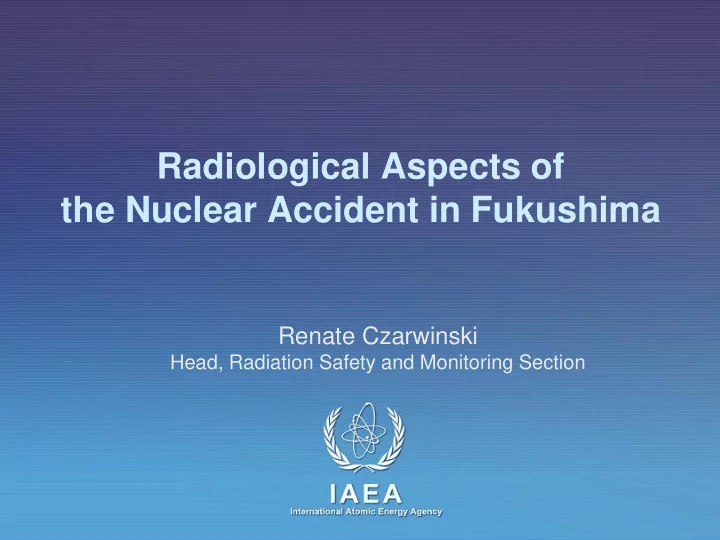

Radiological Aspects of the Nuclear Accident in Fukushima Renate Czarwinski Head, Radiation Safety and Monitoring Section IAEA International Atomic Energy Agency
Earthquake and Tsunami • Earthquake 11th March 2011 14:46JST (05:46 UTC) 70 km east of Oshika Peninsula of Tohoku, hypocenter underwater 32 km, magnitude 9.0 • Tsunami wave up to 38 metres height, in some cases 10 km inlandwards (>9.3 m at Soma in Fukushima prefecture) Aftershocks: 5 with magnitude >7 76 with magnitude >6 IAEA 444 with magnitude >5
Earthquake and Tsunami Japanese National Police Agency reported at 29 th April: 14755 deaths Source: Wikipedia Burning Oil refinery in Sendai 5279 injured persons 10706 missing people across 18 prefectures 125000 buildings damaged or destroyed IAEA
Nuclear emergency at Fukushima NPP • Declaration of the nuclear emergency by Japanese Government on 11th March 16:36 JST IAEA
Nuclear emergency at Fukushima NPP • Estimated release (NISA: Nuclear and Industrial Safety Agency, Japan for the assignment of the INES scale level 7 in April) • I-131: 130 PBq (Chernobyl: 1,800 PBq) • Cs-137: 6.1 PBq (Chernobyl: 85 PBq) IAEA
General information Convention on an Early Notification of an Accident Convention on Assistance in the Case of a Nuclear Accident or Radiological Emergency International Basic Safety Standards for Protection against Ionizing Radiation and for the Safety of Radiation Sources (BSS) Joint FAO/WHO Codex Alimentarius IAEA
General information IAEA
On-site situation Fukushima Dai-ichi The highest recorded value at the site was 400 mSv/h. IAEA 8 This was recorded at a different on-site location and is not included in the graph.
Gamma-dose rate at Tochigi, 140 km South West (microSv/h) Passage of the radioactive plume Resulting exposure pathways are • External exposure from the cloud • Inhalation of contaminated air during the passage of the plume 14 March 16 March 17 March 15 March IAEA
Fukushima – IAEA measurements 4 IAEA teams in Japan 17 th March to 18 th April Objective : to perform environmental monitoring to provide independent IAEA monitoring results and to provide trend analysis for each location. IAEA
Fukushima – IAEA measurements • Measurement of gamma/beta dose rates. • Measurement of gross gamma/beta contamination. • Measurement of gross alpha contamination • Determine radionuclide specific ground deposition by in-situ gamma spectrometry. • Personnel and equipment contamination monitoring • Decontamination of people and equipment • Personal dosimetry • Collection of air samples and smears for field assessment and laboratory analysis. • Collection of samples of contaminated soil, vegetation and water for lab analyisis. IAEA
Fukushima – IAEA measurements • Measurement of dose rates and surface contamination level between 20 km ~ 80 km from the NPP • Gamma spectra, air filter, smears, soil samples are taken in the field. • The results are in agreement with MEXT(~20%) IAEA
Fukushima – IAEA measurements Some difficulties IAEA
Fukushima – IAEA measurements The “tripod” measurement “On box” measurement geometry arrangement geometry arrangement using the GL2830 HPGe detector. with the BE1015 HPGe detector. IAEA
Fukushima – IAEA measurements • The measurement arrangement in the tsunami region. The in-situ measurement setup is on the back. The soil sampling area (50x50 cm 2 ) is at the front. IAEA
First assessment of exposure First assessment of exposure (external and inhalation) for Tokyo, Chiba, Gunma, Saitama, Kangawa, Tochigi 14 – 30 March 2011 Total dose for adults: 0.2 to 0.4 mSv IAEA
Fukushima – IAEA measurements Peak identification in the high-energy region (> 100 keV) of the gamma-spectra IAEA
Fukushima – IAEA measurements Percentage of the total contamination of the top soil by different gamma-emitting nuclides as resulted from the gamma-spectrometric measurements performed by teams 2, 3 & 4 IAEA
Dose assessments Isodoses of accumulated doses (in mSv) until 11 March 2012 (calculated based on data available until 21 April 2011 and on the assumption that same conditions continue, i.e. there is no further major release beyond 21 April 2011) red line is border line of 20 mSv serving as input for Japanese Government decisions countermeasures IAEA
Monitoring of public and workers • As of April 27: 175045 people had been screened (NISA) • Internal + External doses received by emergency workers until the end of March 2011 (TEPCO): • 2 workers: 200-250 mSv. • 8 workers: 150-200 mSv • 11 workers: 100-150 mSv. • Other workers: below 100 mSv. IAEA
Fukushima – IAEA’s approach • Regular briefings to the Member States on status of the Fukushima Daiichi and other reactors and the radiological situation • In-house: establishment of FACT (Fukushima Accident Consequences Team) with two specific teams of FNST and FRCT. • Support by external experts in first dose assessments • IAEA Ministerial Conference on Nuclear Safety, 20 – 24 th June 2011, Vienna IAEA
Aerial monitoring Measurement results by DOE and MEXT Ground level dose rate (microSv / hour) (normalized to 29 th April, 2011) IAEA
Aerial monitoring Measurement results by DOE and MEXT Deposition of Cesium-137 in Bq/m2 within 80 km from Fukushima NPP (normalized to 29 th April, 2011) IAEA
Evacuation – Further Protective Actions • Establishment of a no-entry zone around Fukushima Daiichi NPP (in the area within 20 km) • Basic policies concerning re-entry in advance • Fukushima Daini NPP: evacuation zone reduced from 10 km to 8 km Planned evacuation zone (defined areas where planned evacuations are expected to be implemented within one month) Emergency evacuation preparation zones (to be applied to areas between 20 and 30 km (except planned evacuation zones) for sheltering, leaving on own decision) IAEA
Fukushima IAEA
Recommend
More recommend